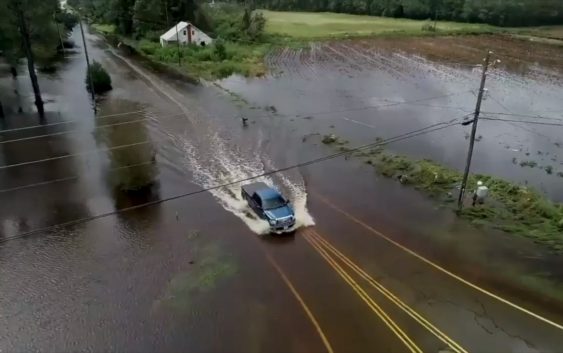- What ignited the deadly California wildfires? Investigators consider an array of possibilities.
- ‘PDS’ warnings were made to grab attention in tornadoes, hurricanes, and now wildfires
- Mexico sends firefighters to aid in fight against Los Angeles wildfires
- Bexar County crews send resources to assist efforts to combat wildfire scorching South California
- Mexico sends firefighters to aid in fight against Los Angeles wildfires
‘Don’t let your guard down,’ Cooper says as NC Hurricane Florence deaths rise to 32

North Carolina Gov. Roy Cooper reported another life claimed by Hurricane Florence on Friday, bringing the state total to 32 deaths and the total in the Carolinas and Virginia to 43.
A 46-year-old man died when a tree he was cutting in Brunswick County fell on him, Cooper announced Friday evening.
Florence is blamed for nine deaths in South Carolina and two in Virginia. North Carolina’s deaths include three children — a 7-month-old in New Hanover County, a 3-month-old in Gaston County and a 1-year-old in Union County.
But it is in Duplin County, a rural county with less than 60,000 people that lies west of Jacksonville and north of Wilmington, that has suffered the greatest loss of life, with eight reported deaths. The southern part of the county was flooded by the northeast portion of the Cape Fear River, which set a record for height.
The previous mark of 23.5 feet was set during 1999’s Hurricane Floyd, said Elizabeth Stalls, the county’s public information officer. Florence eclipsed that mark, but the river’s gauge malfunctioned around 25 feet so there is no official figure for the river’s high mark, Stalls said. Some areas remain flooded, she said.
The county issued a mandatory evacuation for flood-prone areas, Stalls said, but there are no stats on how many people left or stayed.
There were 148 water rescue attempts in the county, but no number on how many people were rescued during those attempts, Stalls said.
Four people died in vehicles caught in flood waters in Duplin County over the weekend the storm passed through the Carolinas.
On Monday, a 74-year-old man and a 22-year-old woman died of carbon monoxide poisoning inside a home in the county.
State officials also announced that an 87-year-old woman and her 81-year-old husband died in Duplin. The woman died after her breathing issues got worse due to a lack of electricity, and her husband died after learning of his wife’s death in a house without power for several days.
“Most of our county was without power for five or six days,” Stalls said.
The county had two shelters open Thursday evening, down from four at the storm’s apex. The state has brought in lots of water and non-perishable meals ready to eat. Stalls said many residents will need household items, and the county is still doing damage assessments. Some of those affected were still rebuilding from 2016’s Hurricane Matthew, she said.
“It’s challenging to be a rural county. We don’t have a large city or municipality on the map,” Stalls said. “We’ve gotten great response from the state for resources we’ve requested.”
Cooper on Saturday said first responders and rescue teams had saved about 5,000 lives over the past week — double the amount rescued after Hurricane Matthew.
More than 23,000 customers remained without power in North Carolina, and more than 4,600 people remained in one of the state’s 42 emergency shelters as of 3 p.m. Saturday, according to the Department of Public Safety.
Cooper continued to stress that people should avoid flooded roadways, and warned that just because weather has improved doesn’t mean people should let their guard down.
“You’ve heard us say it before but I can’t say it too many times: Stay off flooded roads, and don’t drive around barricades,” Cooper said. “The road you plan to drive on may be closed, and the road behind the barricade may not exist anymore underneath the flood water.”
Hurricane Florence made landfall over Wrightsville Beach about 7:15 a.m. on Friday, Sept. 14. It brought several days of heavy rains to eastern North Carolina with more than 35 inches falling in some places, leading to widespread flooding.
The deaths have been attributed to, in part, house fires, motor vehicles crashes, submerged vehicles, falling trees and carbon monoxide poisoning.
North Carolina’s breakdown of deaths, by county:
• Anson: 1
• Brunswick: 1
• Cleveland: 2
• Columbus: 2
• Cumberland: 2
• Duplin: 8
• Gaston: 2
• Lenoir: 2
• New Hanover: 2
• Onslow: 1
• Pender: 1
• Robeson: 1
• Rutherford: 1
• Sampson: 2
• Scotland: 1
• Union: 2
• Wayne: 1